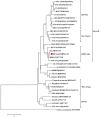Pathobiological and Genomic Characterization of a Cold-Adapted Infectious Bronchitis Virus (BP-caKII)
- PMID: 30463206
- PMCID: PMC6266813
- DOI: 10.3390/v10110652
Pathobiological and Genomic Characterization of a Cold-Adapted Infectious Bronchitis Virus (BP-caKII)
Abstract
We established a cold-adapted infectious bronchitis virus (BP-caKII) by passaging a field virus through specific pathogen-free embryonated eggs 20 times at 32 °C. We characterized its growth kinetics and pathogenicity in embryonated eggs, and its tropism and persistence in different tissues from chickens; then, we evaluated pathogenicity by using a new premature reproductive tract pathogenicity model. Furthermore, we determined the complete genomic sequence of BP-caKII to understand the genetic changes related to cold adaptation. According to our results, BP-caKII clustered with the KII genotype viruses K2 and KM91, and showed less pathogenicity than K2, a live attenuated vaccine strain. BP-caKII showed delayed viremia, resulting in its delayed dissemination to the kidneys and cecal tonsils compared to K2 and KM91, the latter of which is a pathogenic field strain. A comparative genomics study revealed similar nucleotide sequences between BP-caKII, K2 and KM91 but clearly showed different mutations among them. BP-caKII shared several mutations with K2 (nsp13, 14, 15 and 16) following embryo adaptation but acquired multiple additional mutations in nonstructural proteins (nsp3, 4 and 12), spike proteins and nucleocapsid proteins following cold adaptation. Thus, the establishment of BP-caKII and the identified mutations in this study may provide insight into the genetic background of embryo and cold adaptations, and the attenuation of coronaviruses.
Keywords: cold adaptation; comparative genomics; infectious bronchitis virus; persistent infection; premature reproductive tract pathogenicity model.
Conflict of interest statement
The authors declare no conflict of interest.
Figures



Similar articles
-
Kidney Cell-Adapted Infectious Bronchitis ArkDPI Vaccine is Stable and Protective.Avian Dis. 2017 Jun;61(2):221-228. doi: 10.1637/11537-111416-Reg.1. Avian Dis. 2017. PMID: 28665723
-
Pathogenicity and genome changes in QX-like infectious bronchitis virus during continuous passaging in embryonated chicken eggs.Virus Res. 2020 May;281:197911. doi: 10.1016/j.virusres.2020.197911. Epub 2020 Mar 3. Virus Res. 2020. PMID: 32142742
-
Changes in nonstructural protein 3 are associated with attenuation in avian coronavirus infectious bronchitis virus.Virus Genes. 2012 Feb;44(1):63-74. doi: 10.1007/s11262-011-0668-7. Epub 2011 Sep 10. Virus Genes. 2012. PMID: 21909766 Free PMC article.
-
Characterization of S1 gene sequence variations of attenuated QX-like and variant infectious bronchitis virus strains and the pathogenicity of the viruses in specific-pathogen-free chickens.Arch Virol. 2020 Dec;165(12):2777-2788. doi: 10.1007/s00705-020-04812-2. Epub 2020 Sep 22. Arch Virol. 2020. PMID: 32964293
-
Replicase 1a gene plays a critical role in pathogenesis of avian coronavirus infectious bronchitis virus.Virology. 2020 Nov;550:1-7. doi: 10.1016/j.virol.2020.08.009. Epub 2020 Aug 20. Virology. 2020. PMID: 32853833 Free PMC article.
Cited by
-
Effects of G and SH Truncation on the Replication, Virulence, and Immunogenicity of Avian Metapneumovirus.Vaccines (Basel). 2024 Jan 21;12(1):106. doi: 10.3390/vaccines12010106. Vaccines (Basel). 2024. PMID: 38276678 Free PMC article.
-
Pathogenicity of the Canadian Delmarva (DMV/1639) Infectious Bronchitis Virus (IBV) on Female Reproductive Tract of Chickens.Viruses. 2021 Dec 11;13(12):2488. doi: 10.3390/v13122488. Viruses. 2021. PMID: 34960757 Free PMC article.
-
Current Knowledge on Infectious Bronchitis Virus Non-structural Proteins: The Bearer for Achieving Immune Evasion Function.Front Vet Sci. 2022 Apr 8;9:820625. doi: 10.3389/fvets.2022.820625. eCollection 2022. Front Vet Sci. 2022. PMID: 35464391 Free PMC article. Review.
References
-
- Fang S.G., Shen H., Wang J., Tay F.P., Liu D.X. Proteolytic processing of polyproteins 1a and 1ab between non-structural proteins 10 and 11/12 of Coronavirus infectious bronchitis virus is dispensable for viral replication in cultured cells. Virology. 2008;379:175–180. doi: 10.1016/j.virol.2008.06.038. - DOI - PMC - PubMed
Publication types
MeSH terms
Grants and funding
LinkOut - more resources
Full Text Sources

